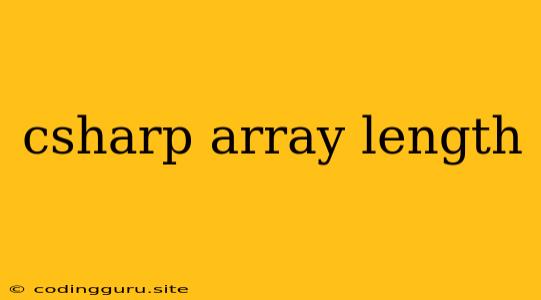Understanding C# Array Length: A Comprehensive Guide
In the world of C# programming, arrays are fundamental data structures that allow you to store collections of elements of the same data type. One of the most common tasks you'll encounter when working with arrays is determining their size. This is where the Length property comes into play.
What is the Length Property?
The Length property is an integral part of the C# array system. It provides you with a straightforward way to retrieve the number of elements contained within an array. This information is crucial for various operations, such as looping through elements, performing calculations, or managing memory allocation.
How to Use the Length Property
Using the Length property is incredibly simple. You can access it directly on any array variable. Here's a basic example:
int[] numbers = { 1, 2, 3, 4, 5 };
int arrayLength = numbers.Length;
Console.WriteLine("The array has {0} elements.", arrayLength); // Output: The array has 5 elements.
In this code snippet, we first create an array named numbers and initialize it with five integers. Then, we use the Length property to store the array's size in the arrayLength variable. Finally, we display the result to the console.
Why is Length Important?
The Length property plays a critical role in many common array operations:
- Looping through elements: You can use the
Lengthproperty to control the iterations of loops likeforloops, ensuring you iterate through every element in the array.
for (int i = 0; i < numbers.Length; i++)
{
Console.WriteLine(numbers[i]);
}
- Boundary checks: It's essential to prevent errors by ensuring your code doesn't access elements beyond the array's bounds. The
Lengthproperty helps you implement these checks, preventing unexpected behavior.
if (index < numbers.Length)
{
// Access the element at the given index
}
else
{
// Handle invalid index
}
- Memory management: Understanding the array's size through
Lengthis crucial for efficient memory management. It allows you to allocate the right amount of memory for your array, avoiding unnecessary overhead.
Examples and Best Practices
Here are some additional examples and best practices to help you master the Length property:
- Calculating the average of elements:
int[] numbers = { 10, 20, 30, 40, 50 };
int sum = 0;
for (int i = 0; i < numbers.Length; i++)
{
sum += numbers[i];
}
double average = (double)sum / numbers.Length;
Console.WriteLine("The average is: {0}", average); // Output: The average is: 30
- Finding the maximum value in an array:
int[] numbers = { 10, 20, 3, 40, 5 };
int max = numbers[0];
for (int i = 1; i < numbers.Length; i++)
{
if (numbers[i] > max)
{
max = numbers[i];
}
}
Console.WriteLine("The maximum value is: {0}", max); // Output: The maximum value is: 40
- Avoid using
Lengthfor bounds checking in loops:
While you can use Length for bounds checking, it's generally recommended to use the for loop's built-in range checking mechanism. This is because it's more concise and reduces potential for errors.
for (int i = 0; i < numbers.Length; i++) // Prefer this
{
// Code
}
// Instead of
for (int i = 0; i <= numbers.Length - 1; i++)
{
// Code
}
Conclusion
The Length property is a fundamental tool for working with arrays in C#. It provides a straightforward and efficient way to determine the size of an array, enabling you to perform essential operations like looping, bounds checking, and memory management. By understanding and utilizing this property effectively, you can write more efficient and reliable C# code.
